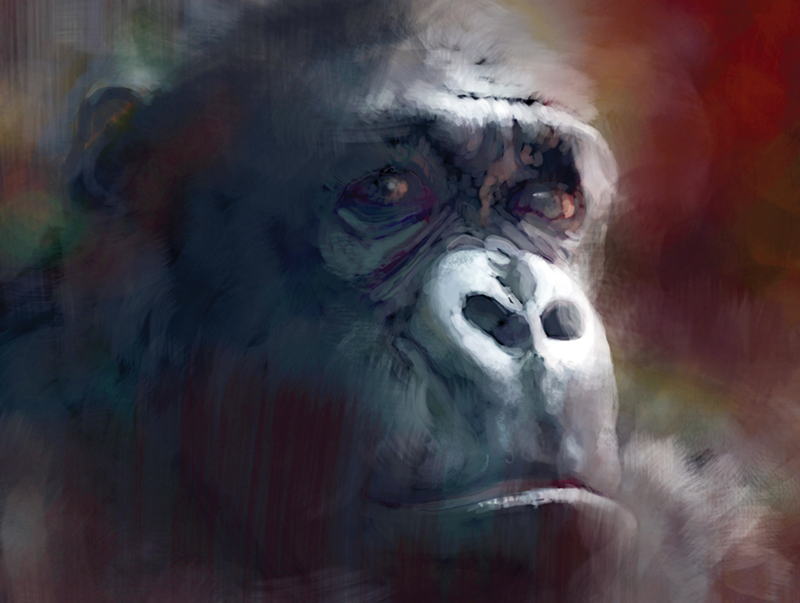Could art be the missing link? Oxford, Ohio, native John Bavaro would probably say yes. His current exhibition in the Duveneck Gallery at the Carnegie Center Visual and Performing Arts Center in Covington uses both traditional and digital painting to examine the similarities between humans and non-human primates. The exhibition is a sort of homecoming for Bavaro, who left Cincinnati in 2001 for a faculty post at Edinboro University in Pennsylvania.
First, a quick zoology lesson. Primates include humans and various groups of apes and monkeys, including chimpanzees, bonobos, gorillas, orangutans, gibbons, lemurs and others. Bavaro’s project runs the gamut with 73 painted portraits and 18 digital paintings done on his iPhone and printed in large format. The paintings encompass the entire gallery, hung side against side, salon-style. The effect is mesmerizing — it’s hard to tell where the humans leave off and the apes begin. Many of the humans gaze more distantly than their non-human primate counterparts, who grin, frown or stare soulfully. It’s exactly the point that Bavaro is trying to make. “There is as much ‘humanity’ in a great ape as there is wildness in a human being,” he writes in his statement for the show. “And there is a mystery in all of us that art can capture what science cannot.”
My husband and I are included in Bavaro’s gallery of primates, myself sandwiched between “Bakari” and “Bebac,” two lowland gorillas, and my husband between a bonobo and a Bornean orangutan. It’s humbling to see yourself displayed without adornment or idealization among animals, but also an honor, like being part of an extended family. “Their genes are in us, too,” Bavaro states.
Like Spanish Baroque painter Diego Velazquez, Bavaro reaches into his subjects to paint them with dignity. In the 1600s, Velazquez painted deeply moving portraits that humanistically elevated the underclass of the Spanish court such as dwarves who were exploited as entertainers.
Bavaro sends a similar message about our primate cousins — that they should be regarded with the same respect we give to each other. He portrays primates at all ages, the older apes and people sharing the wizened, wrinkled countenance of life experience. “Biology and psychology are beginning to solve puzzles about cognizance, emotion and intelligence in non-humans and humans alike,” Bavaro writes. “But the poetic, interpretive powers of art can look into the soul in a way that a microscope ... or brain scan cannot.”
It’s fascinating that Bavaro, who praises the ability of painting to reach into the character of his subjects and the inability of science to understand the soul, has also embraced an electronic medium. He has mastered “finger-painting” — using inexpensive iPhone apps such as Brushes, Sketchbook Mobile or Paintbook — to create digital works of art. Using a finger or a stylus, the artist can control elements like colors, degrees of transparency or opacity, types of brushes, and textures. Users can zoom in on areas to add minute detail. Apps can be used alone or in combination, and just as in traditional media, artists’ approaches and methods of working vary widely.
The “finger-painting” community has grown exponentially over the past couple of years, and Bavaro has been one of the field’s pioneers and proponents. With four other artists he cofounded the International Association of Mobile Digital Artists last year. He also served as the coordinator of the first-ever MobileArtCon, an international conference at New York University.
Painterly, warm and atmospheric, the 18 large-format iPhone prints in the Carnegie show transcend the potentially impersonal art-making technique, a result Bavaro says is because he can use his finger rather than a stylus. “The directness of actually touching the screen makes it seem as though the art is coming directly from my own finger rather than the program,” he told me. “It’s a weird sensation, but it seems to have removed the wall that kept me away from digital art.”
With this exhibition of both traditional and digital paintings, however, it’s clear that Bavaro is not quite ready to put down his paintbrush for good.
John Bavaro's GENUS: PRIMARILY PRIMATE is on view through Oct. 7 in the Carnegie’s Duveneck Gallery. www.thecarnegie.com






